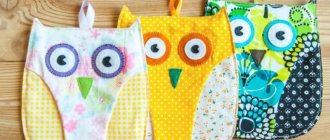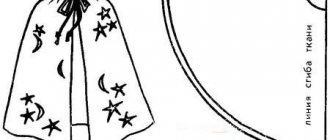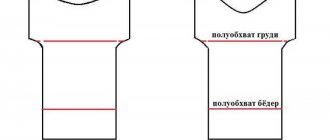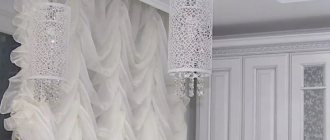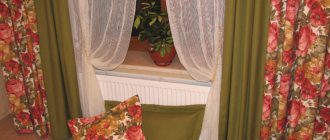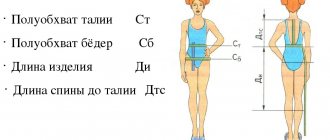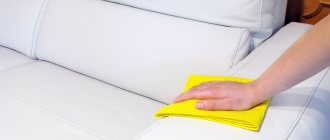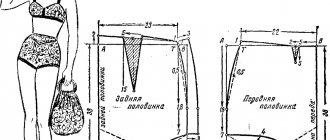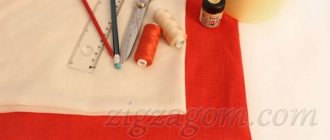Pajamas in the wardrobe
For a comfortable sleep, there is nothing better than beautiful and stylish pajamas. It can be presented in a wide variety of variations, from different materials. Fabric and finished goods stores are ready to offer their customers a wide range of goods for every taste.
However, the most original pajamas can be made with your own hands at home. At the same time, it is not necessary to have special skills and craftsmanship; it is enough to have proper command of a needle and thread. And step-by-step instructions and video lessons from experienced needlewomen will allow you to master a further sewing course.
Types of pajamas for independent work
Any pajama model contains two main elements: the top and the bottom. In this case, the upper half can be presented in the form of a T-shirt, T-shirt, light top or insulated blouse with long sleeves.
The lower part can also be sewn in the form of trousers, short shorts or medium-length breeches. The tailoring form is chosen depending on the season of the year, the type of heating in the apartment (private house) and the personal wishes of the owner.
Assembling the pants
Fold the trouser legs in half lengthwise, with the front part facing inward, and sew the inner seams (Fig. 15).
Turn one pant leg right side up, leave the other one unchanged. Place the inside-out pant leg into the other one, aligning the crotch cuts and side seams (Fig. 16).
Connect the step sections with tailor's pins (Fig. 17), sew a stitch and turn the product inside out (Fig. 18).
Fold the edge of the top of the pants and make a straight seam, insert the elastic - the belt is ready (Fig. 19).
Decorate the bottom of the legs with cuffs, similar to the sleeves of pajamas.
Warm children's pajamas are ready (Fig. 20).
If you want to sew pajamas for a child using a pattern, watch this video:
Step-by-step sewing pajamas
When starting work, you must remember that inexperienced craftswomen should begin their independent work with simple work. It is better to give preference to simple pajama models that do not have auxiliary decorative details, intricate buttons, hooks, or cords.
You should also consider the purpose of the homemade product. For a young child, it is better to choose pajamas without fasteners or small parts that the child can tear off and accidentally swallow.
How to choose the color of children's pajamas?
There is no shortage of fabrics on store shelves today. However, remember that pajama design needs to be taken seriously. For example, many mothers want to sew pajamas for their son in the shape of a superhero costume.
However, it will be extremely difficult to put your baby to bed in such pajamas, because children get carried away so easily. And then try to convince him that you dressed him as Spider-Man so that he would go to bed and not go off to perform heroic deeds.
This wardrobe item with bright pictures will produce approximately the same effect. The baby will want to show his brother, sister, grandmother, aunt, uncle in it, but just going to bed in it is so boring.
It is better to give preference to fabric with dim pictures or even one color. This point is especially important for children who suffer from sleep disorders.
Selection of tools for work
You should begin independent cutting and sewing activities by organizing your workplace. Working with a needle and thread requires painstaking work and constant eye strain. In order to reduce the load on the muscles of the back, arms and shoulders, carefully select the height of the table and chair.
To relieve the eye muscles, you should prepare the optimal level of natural and artificial lighting. You will also need the following set:
- A set of patterns for preparing patterns.
- Sharp scissors that will not tear the edges of textiles.
- Tape measure.
- Pencil.
- Sewing machine.
- Decorative elements (if they are provided for this model).
- Threads and needles for hand stitches.
Step-by-step instructions for sewing pajamas with a detailed description of each stage of the work may also be useful (for example, how to sew silk pajamas with short shorts).
Sew pajama pants without a pattern?
To sew pajama pants without a pattern you will need:
- any home pants
- meter of fabric
- threads to match the fabric
- sewing machine
- chalk or soap
- scissors
Manufacturing technology of pajama pants:
- Fold the fabric in half.
- Place the house pants folded vertically on top of the fabric.
- Use chalk to outline the pants. Add 1-1.5 cm everywhere for allowances.
- Cut out the pants pieces with sharp scissors.
- Sew the pieces: First sew the seat pieces (fly).
- After this, side seams.
- For the bottom seams, be sure to fold the pants in by 1cm.
- At the top (where the elastic will be), make a 2 cm bend and sew with a straight stitch.
You should have these pajama pants
Selection of materials for sewing
The next stage in independent work is the optimal selection of the textile base. In this case, first of all, a number of individual characteristics of the future owner are taken into account:
- Age.
- Presence of allergic reactions.
- Sensitivity of the skin.
Today there are three groups of fabric bases on sale: made from natural threads, synthetic and combined fabrics. Each presented option has a number of pros and cons as a practical choice.
Natural fabrics allow air to pass through perfectly, allowing the skin to breathe. In addition, they do not heat the skin, do not absorb unpleasant odors, and do not cause allergic reactions. However, despite the presence of a large number of advantages, such canvases are not without disadvantages.
Pajamas made exclusively from natural fibers quickly lose their shape, shrink, and lose their original color. Synthetic fibers are durable, resistant to frequent washing, and do not lose color. However, for children's pajamas this option is absolutely unacceptable due to frequent allergic reactions on delicate skin.
Artificial fabrics do not allow air to pass through well, can irritate the skin, and also quickly absorb sweat odors. For this reason, mixed types of textiles, in which natural and synthetic threads are in optimal proportions, are very popular today.
Quantity of material
To figure out how to properly sew children's pajamas, you need to learn how to calculate the amount of material required for the work. The easiest way is to use a special table that shows the approximate fabric consumption for a standard fabric width of 180 cm:
| Height (pajama size) | Quantity of material, cm |
| 80 | 86 cm |
| 86 | 90 cm |
| 92 | 95 cm |
| 98 | 99 cm |
| 104 | 104 cm |
| 110 | 108 cm |
| 116 | 112 cm |
| 122 | 135 cm |
| 128 | 143 cm |
| 134 | 151 cm |
| 140 | 157 cm |
| 146 | 161 cm |
| 152 | 172 cm |
| 158 | 177 cm |
In addition, you need to prepare a piece approximately 20 cm long from ribana or cashcorse for cuffs and neck edging (with a fabric width of 120 cm) and an elastic band 2.5 cm wide.
Preparation of patterns
In any situation, an inexperienced needlewoman has the opportunity to use ready-made patterns. However, if you want to sew pajamas with a unique design, you should measure the chest circumference, neck circumference, and waist circumference.
Next, you should calculate the height of the armhole and collar for the sleeve. For the lower part, you will need to calculate the circumference of the hips and the length of the trouser leg. For long pajamas, you should first calculate the width of the calf muscle. All results obtained must be transferred to paper using a pencil and ruler.
How to sew women's pajamas with your own hands for beginners: patterns
To sew your own women's pajamas, consisting of pants and a T-shirt, you will need:
- several meters of fabric
- scissors
- threads to match the fabric
- graph paper
- simple pencil
- ruler
- chalk
- safety pins
Patterns for women's pajamas.
Pattern No. 1
Pattern No. 2
Description of work:
How to sew a top
How to sew a bottom
The finished pajamas will look like this
Preparing parts and assembling the product
The final stage, also known as the main stage of independent work, is carried out according to the following instructions on how to sew pajamas with your own hands for beginners:
- The prepared textile fabric is washed to provide the first shrinkage for the fabric.
- Then the textiles are carefully smoothed with an iron.
- Using pre-prepared patterns, parts for assembly are cut out: a single piece of the front, two parts of the back, sleeves (if necessary), parts of the bottom.
- During the marking process (on the reverse side of the textile), be sure to leave 1.5-2.0 cm of fabric for the seams. When cutting out elements, use only sharp sewing scissors, which will not leave nicks or uneven cuts.
- The edges of the textile left on the seams are smoothed with an iron.
- Using a thread and a needle, mark the joints of the parts with hand stitches. The work uses the technique of large hand stitches, which can then be easily removed.
- For a T-shirt or light top, straps are sewn on, the edges of the neckline and cutouts are tucked in. They are also basted with large hand stitches.
- The next task facing the craftswoman is working with a sewing machine. All hand stitches must be duplicated with neat line stitches.
- After assembling the lower part (pants legs, short shorts, breeches), the upper contour is stitched, leaving a small channel inside. An elastic band or cord is passed through this channel to hold the pajama pants on the hips.
For edge sections (neckline, sleeves or hem), you can use beautiful decorative stitches. Also for adult pajamas, lacing is used on the front surface of the T-shirt, small buttons, and soft Velcro. For independent work, you can use detailed instructions on how to sew pajamas from satin with lace. Such accessories will become a real decoration of the wardrobe of any fashionista.
For children's pajamas, there are a number of tailoring features: there must be a complete absence of small parts that will rub the baby's delicate skin. It is also better to avoid excess seams, fasteners, and buttons.
Pajama style
The pattern of children's pajamas for boys is presented, as a rule, in the form of a loose-fitting jacket and the same pants. For younger children, you can also sew a onesie. The main rule is that it is better to make your pajamas a little larger: nothing should hinder your movements during sleep.
Children's pajama patterns for girls are available in a wider range. The most classic option is close to men's, that is, wide pants and a wide shirt. A more modern analogue is narrow pants that resemble men's long johns with an elastic band at the ankle. The summer option can consist of short shorts and a tank top with straps.

